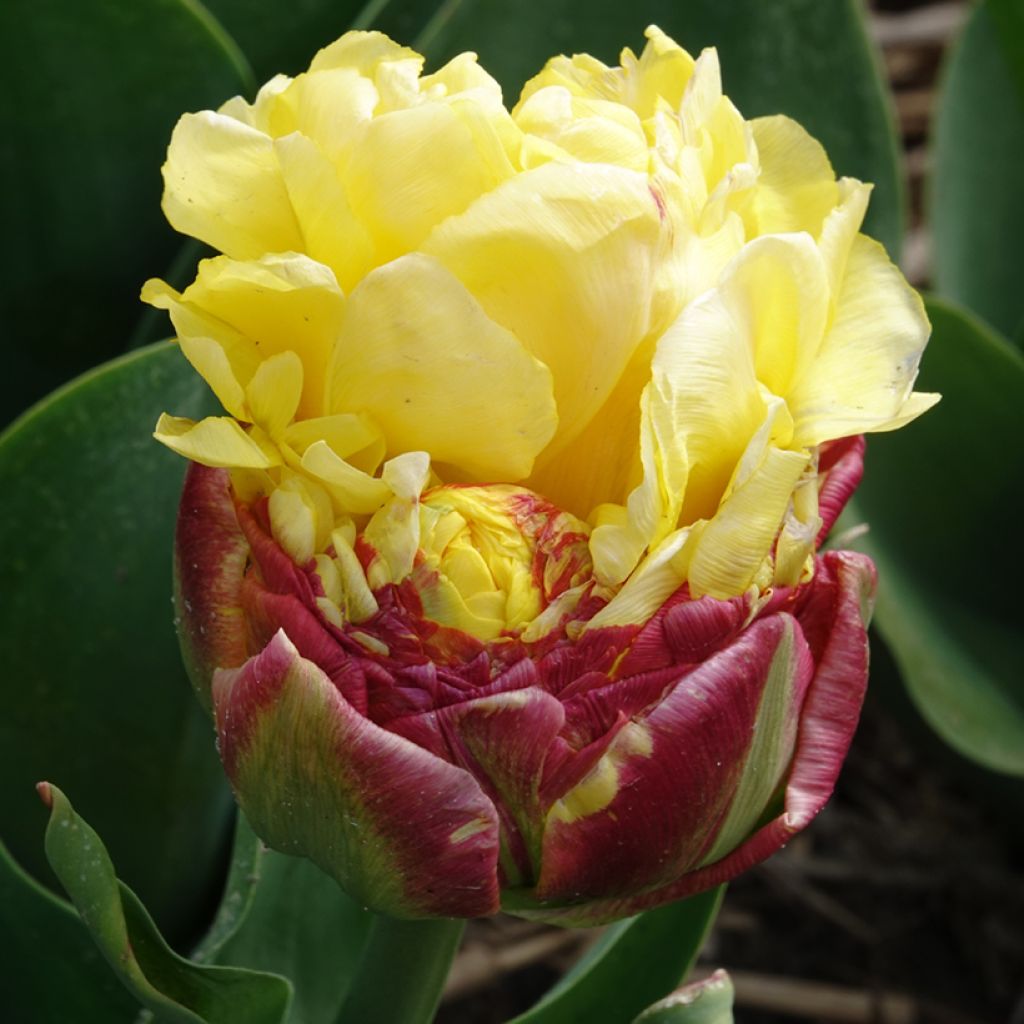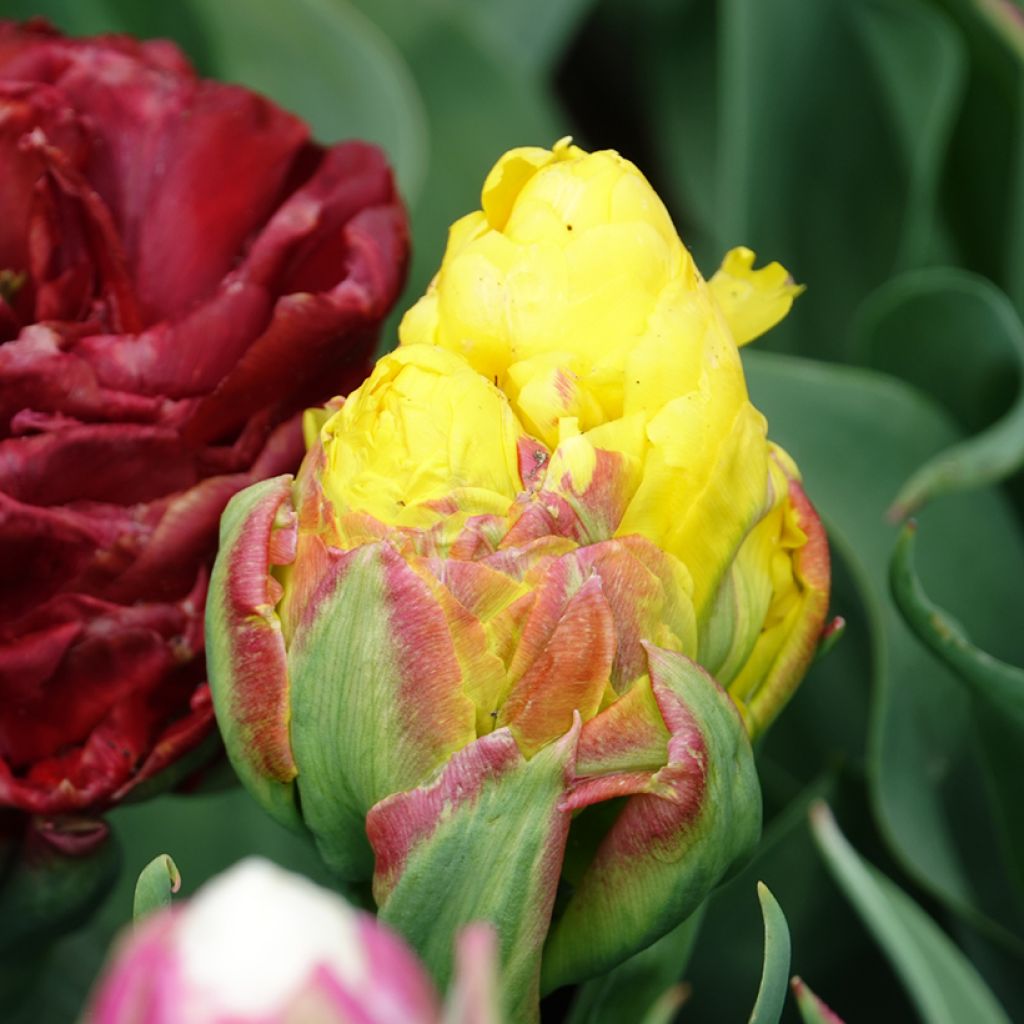

Tulipa Ice Cream Banana - Double late Tulip


Tulipa Ice Cream Banana - Double late Tulip
Tulipa Ice Cream Banana - Double late Tulip
Tulipa Ice cream Banana
Tulip
This plant carries a 6 months recovery warranty
More information
We guarantee the quality of our plants for a full growing cycle, and will replace at our expense any plant that fails to recover under normal climatic and planting conditions.
From €5.90 for pickup delivery and €6.90 for home delivery
Express home delivery from €8.90.
Does this plant fit my garden?
Set up your Plantfit profile →
Description
The 'Ice Cream Banana' Late Double Tulip is as attractive as the most delicious ice cream! This variety offers truly original flowers, composed of a central frill of tightly packed yellow petals, surrounded by reddish-purple petals mixed with green. The stem is short and sturdy, making it useful in the garden, in pots, and in containers. This tulip naturally pairs well with the variety 'Ice Cream'.
The 'Ice Cream Banana' Tulip belongs to the Liliaceae family. Of horticultural origin, introduced to the Netherlands in 2020, it is currently classified in the group of "Late Double Tulips", whose main characteristic is to present very double and crumpled flowers, in the shape of peonies. 'Ice Cream Banana' is not very tall (35-40 cm) and its large flower is double and curiously arranged. When it forms, the flower seems to be dark pink, but suddenly a tall corolla filled with yellow petals appears in its centre. Flowering takes place in mid-May, at the end of the tulip season. The flowers last a long time in a vase or in the garden. The foliage dries out some time after flowering, while the bulb goes into dormancy.
With varied colours, tender or bright, opulent and simple flowers, extravagant or charming, late double tulips bring a touch of fantasy to gardens and sunny terraces. 'Ice Cream Banana' will delight fans of the 'Exquisit' tulip, both of which seem to come from another world. To highlight them, plant them in the midst of small, delicate flowers such as chamomile or the white forget-me-not 'Snowsylva'. 'Ice Cream Banana' will also be very beautiful on a carpet of lady's mantle.
Consider the height and flowering period when designing your flower beds, as these parameters can vary significantly from one cultivar to another. It is a good idea to plant a few extra bulbs for bouquets, as they last a long time in a vase.
Regarding botanical species: wild tulips are found from Western Europe to China and Japan, passing through Eastern Europe, Asia Minor, and Central Asia. Their distribution area also includes North Africa and the Indian subcontinent. The centre of diversity of the Tulipa genus is located in the Pamir and Hindu Kush mountains, as well as in the steppes of Kazakhstan.
Report an error about the product description
Plant habit
Flowering
Foliage
Botanical data
Tulipa
Ice cream Banana
Liliaceae
Tulip
Tulipa Ice cream Banana
Cultivar or hybrid
Planting and care
Plant the 'Ice Cream Banana' tulip bulbs in the autumn, from September to December, at a depth of 15 cm, spacing them 10 cm apart in ordinary, slightly acidic, neutral, or slightly chalky, loose, well-worked, and well-draining soil. Never add manure or poorly decomposed compost to the planting soil, as this could cause the bulbs to rot. The tulip will grow well in moist to moderately dry soil in the summer. Place it in a good, sunny or semi-shaded location. Once flowering is complete, remove the seed heads to avoid exhausting the bulb.
Planting period
Intended location
Care
This item has not been reviewed yet - be the first to leave a review about it.
Haven't found what you were looking for?
Hardiness is the lowest winter temperature a plant can endure without suffering serious damage or even dying. However, hardiness is affected by location (a sheltered area, such as a patio), protection (winter cover) and soil type (hardiness is improved by well-drained soil).

Photo Sharing Terms & Conditions
In order to encourage gardeners to interact and share their experiences, Promesse de fleurs offers various media enabling content to be uploaded onto its Site - in particular via the ‘Photo sharing’ module.
The User agrees to refrain from:
- Posting any content that is illegal, prejudicial, insulting, racist, inciteful to hatred, revisionist, contrary to public decency, that infringes on privacy or on the privacy rights of third parties, in particular the publicity rights of persons and goods, intellectual property rights, or the right to privacy.
- Submitting content on behalf of a third party;
- Impersonate the identity of a third party and/or publish any personal information about a third party;
In general, the User undertakes to refrain from any unethical behaviour.
All Content (in particular text, comments, files, images, photos, videos, creative works, etc.), which may be subject to property or intellectual property rights, image or other private rights, shall remain the property of the User, subject to the limited rights granted by the terms of the licence granted by Promesse de fleurs as stated below. Users are at liberty to publish or not to publish such Content on the Site, notably via the ‘Photo Sharing’ facility, and accept that this Content shall be made public and freely accessible, notably on the Internet.
Users further acknowledge, undertake to have ,and guarantee that they hold all necessary rights and permissions to publish such material on the Site, in particular with regard to the legislation in force pertaining to any privacy, property, intellectual property, image, or contractual rights, or rights of any other nature. By publishing such Content on the Site, Users acknowledge accepting full liability as publishers of the Content within the meaning of the law, and grant Promesse de fleurs, free of charge, an inclusive, worldwide licence for the said Content for the entire duration of its publication, including all reproduction, representation, up/downloading, displaying, performing, transmission, and storage rights.
Users also grant permission for their name to be linked to the Content and accept that this link may not always be made available.
By engaging in posting material, Users consent to their Content becoming automatically accessible on the Internet, in particular on other sites and/or blogs and/or web pages of the Promesse de fleurs site, including in particular social pages and the Promesse de fleurs catalogue.
Users may secure the removal of entrusted content free of charge by issuing a simple request via our contact form.
The flowering period indicated on our website applies to countries and regions located in USDA zone 8 (France, the United Kingdom, Ireland, the Netherlands, etc.)
It will vary according to where you live:
- In zones 9 to 10 (Italy, Spain, Greece, etc.), flowering will occur about 2 to 4 weeks earlier.
- In zones 6 to 7 (Germany, Poland, Slovenia, and lower mountainous regions), flowering will be delayed by 2 to 3 weeks.
- In zone 5 (Central Europe, Scandinavia), blooming will be delayed by 3 to 5 weeks.
In temperate climates, pruning of spring-flowering shrubs (forsythia, spireas, etc.) should be done just after flowering.
Pruning of summer-flowering shrubs (Indian Lilac, Perovskia, etc.) can be done in winter or spring.
In cold regions as well as with frost-sensitive plants, avoid pruning too early when severe frosts may still occur.
The planting period indicated on our website applies to countries and regions located in USDA zone 8 (France, United Kingdom, Ireland, Netherlands).
It will vary according to where you live:
- In Mediterranean zones (Marseille, Madrid, Milan, etc.), autumn and winter are the best planting periods.
- In continental zones (Strasbourg, Munich, Vienna, etc.), delay planting by 2 to 3 weeks in spring and bring it forward by 2 to 4 weeks in autumn.
- In mountainous regions (the Alps, Pyrenees, Carpathians, etc.), it is best to plant in late spring (May-June) or late summer (August-September).
The harvesting period indicated on our website applies to countries and regions in USDA zone 8 (France, England, Ireland, the Netherlands).
In colder areas (Scandinavia, Poland, Austria...) fruit and vegetable harvests are likely to be delayed by 3-4 weeks.
In warmer areas (Italy, Spain, Greece, etc.), harvesting will probably take place earlier, depending on weather conditions.
The sowing periods indicated on our website apply to countries and regions within USDA Zone 8 (France, UK, Ireland, Netherlands).
In colder areas (Scandinavia, Poland, Austria...), delay any outdoor sowing by 3-4 weeks, or sow under glass.
In warmer climes (Italy, Spain, Greece, etc.), bring outdoor sowing forward by a few weeks.


































